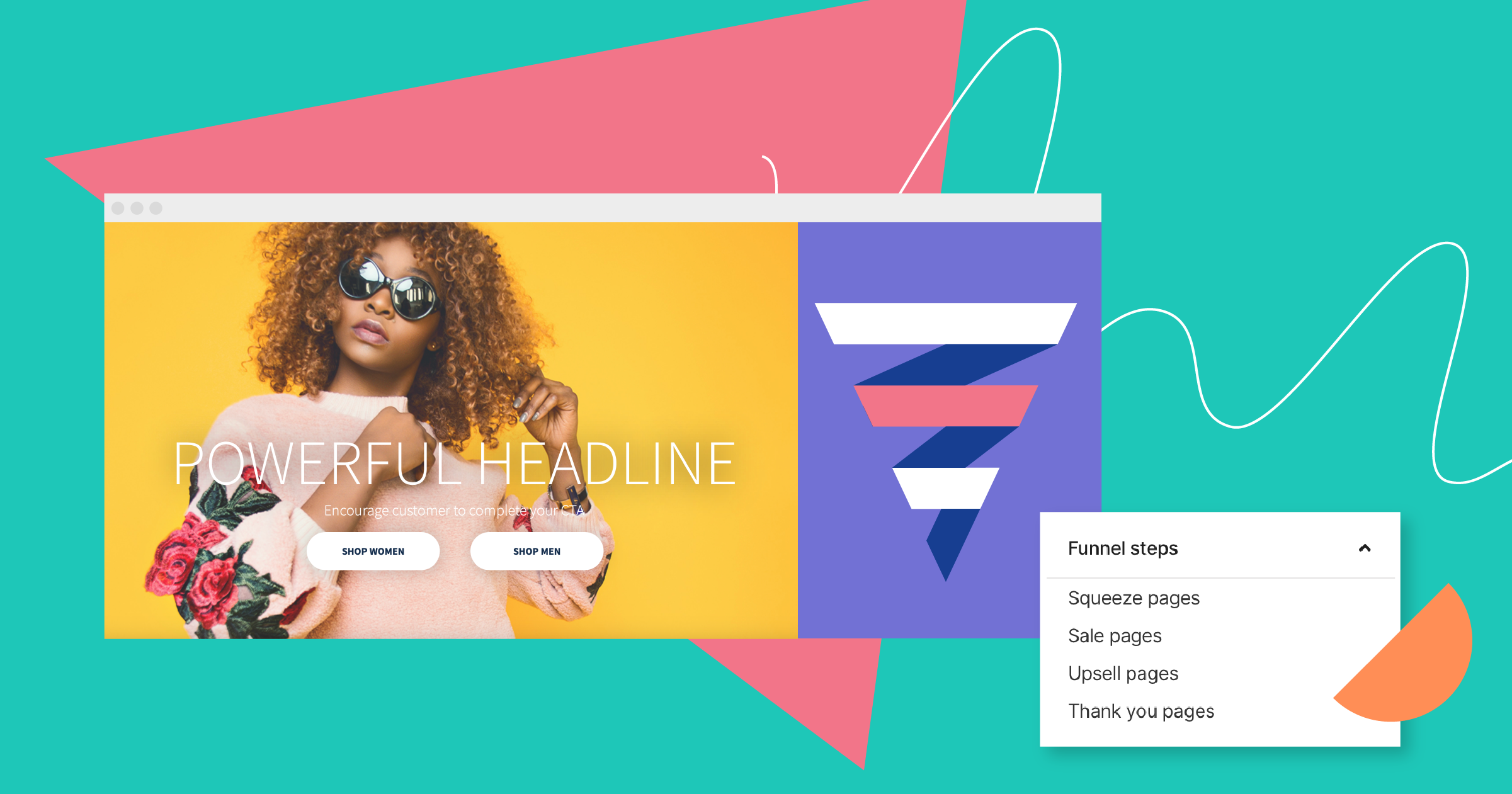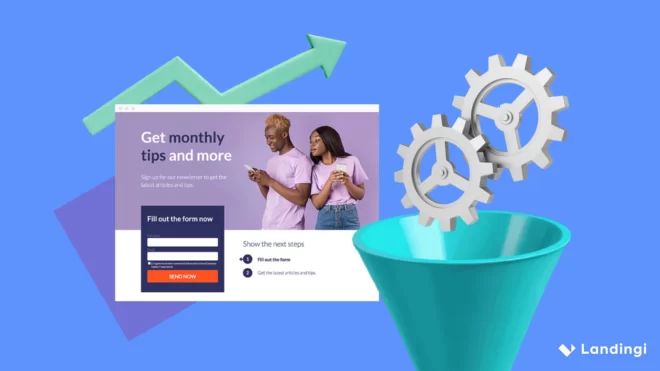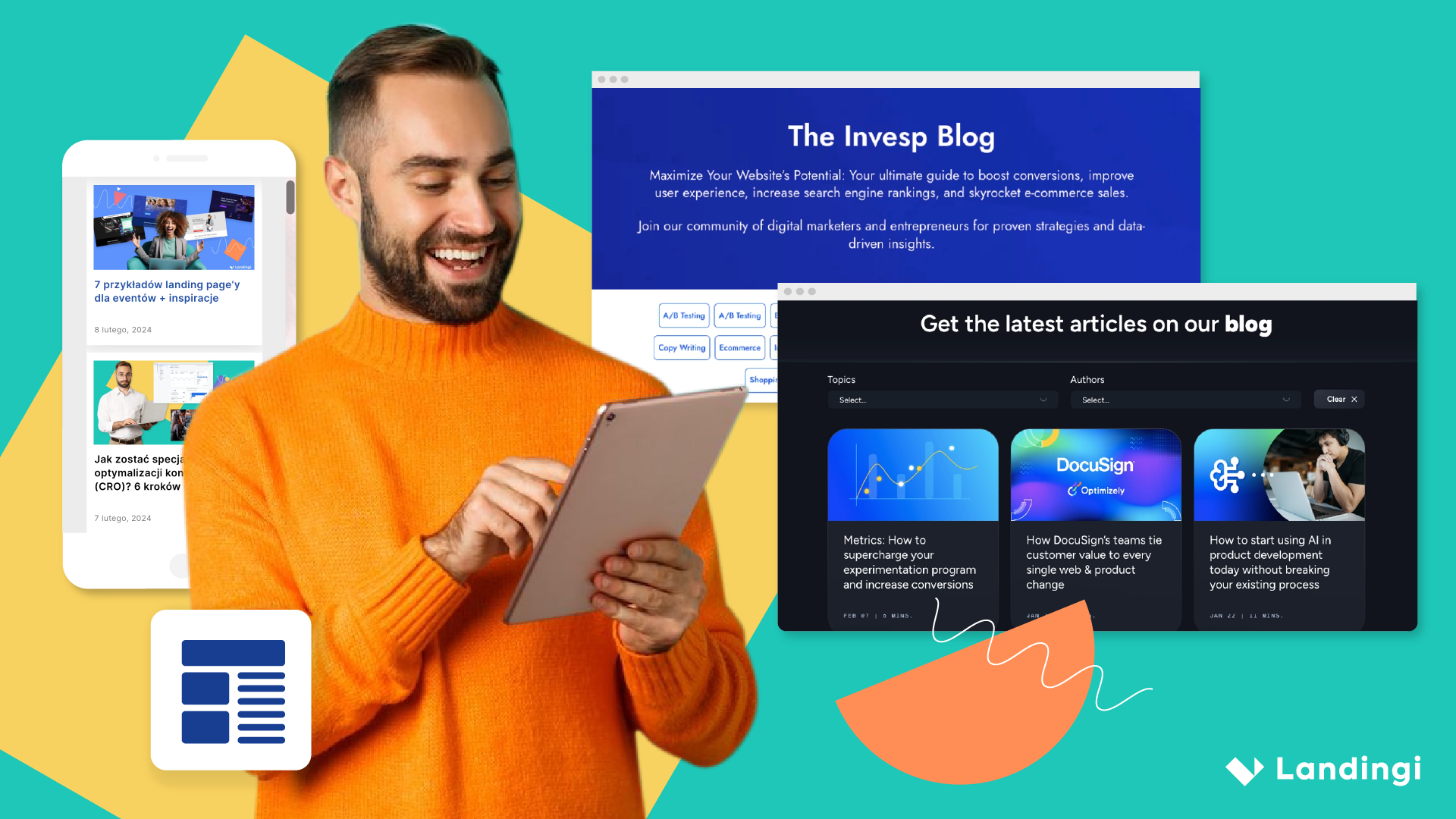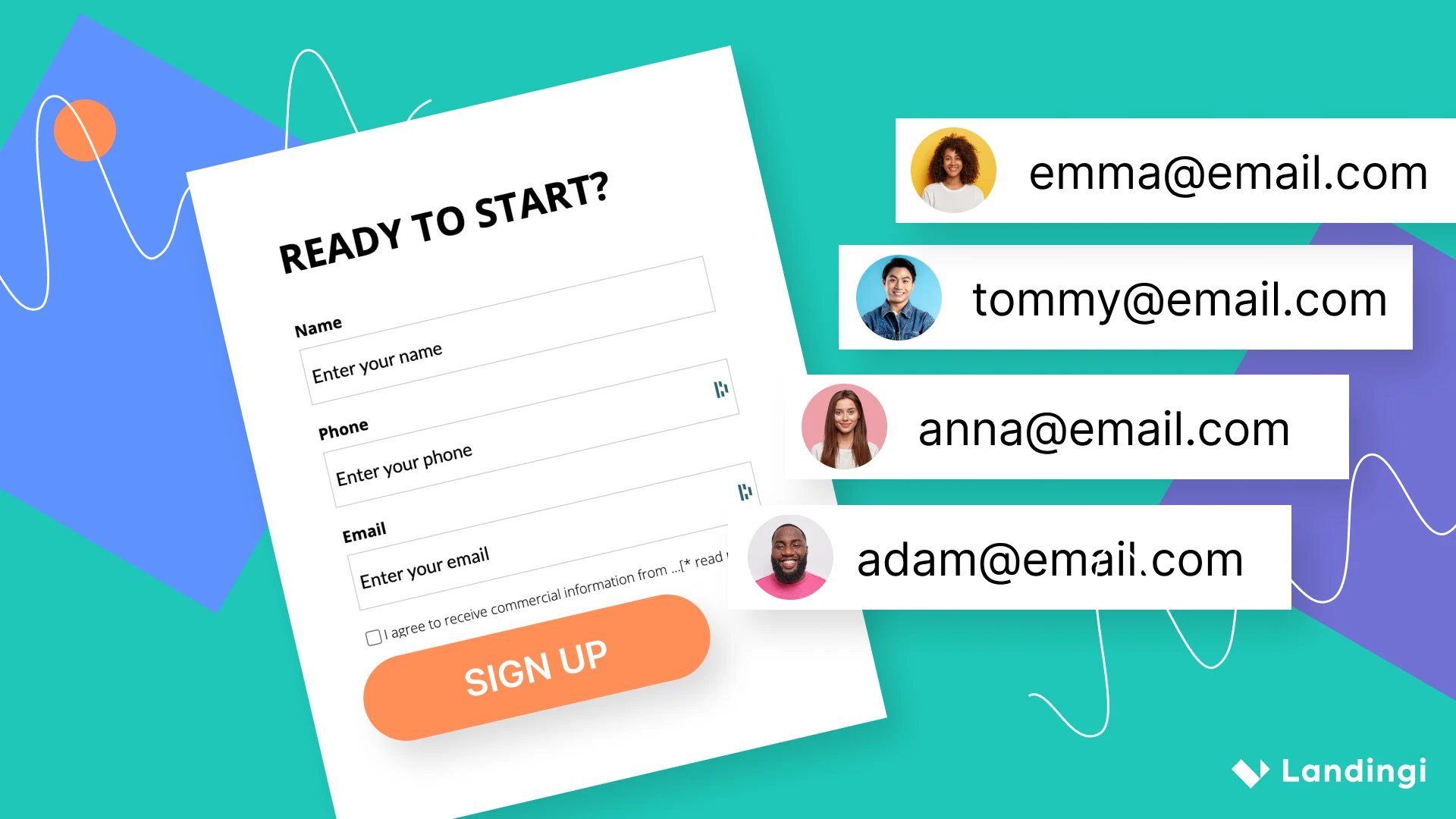As briefly explained in Gabriel Bertolo’s “E-Commerce Conversion Rate Optimization Guide”, a conversion funnel represents the journey a visitor takes from discovering your business, interacting with your website, and finally making a purchase (or not). However, there are quite a lot of nuances involved in marketing funnels beyond this short description.
We have examined them more closely to provide you with a comprehensive overview of conversion funnels, encompassing their definition, key stages, optimization tips, real-world examples, and their profound significance in the realm of marketing.
What Is Conversion Funnel?
A conversion funnel is a set of steps that visitors take from finding out about your business to conversion. Interchangeably called a marketing funnel, it is a framework that represents the customer’s journey from the initial awareness of a product or service to the point where they take a specific action, such as making a purchase, signing up for an event, or requesting more information.
According to Marketo’s “Website and SEO for Lead Generation” ebook, about 96% of visitors who visit your website are not ready to convert. This is where marketing funnels come in handy – they create a structured path that nurtures and persuades potential customers at each stage, increasing the likelihood of them taking the desired action.
This concept is fundamental in digital marketing and web analytics as it helps businesses analyze and optimize their marketing efforts, ultimately improving conversion rates and driving revenue.
What is digital marketing conversion funnel?
The digital marketing conversion funnel is a strategy employed in a digital environment to guide potential customers through a series of online steps that culminate in a desired action – a purchase, signing up for a newsletter, downloading an ebook, etc.
Digital marketing funnel is sometimes referred to as a sales funnel. This concept holds a pivotal role in the realm of online marketing campaigns, empowering businesses to enhance their conversion rates with precision.
What is conversion funnel in web analytics?
In web analytics, the conversion funnel is a key tool for understanding user behavior on a website or application and is used to track and analyze complex paths that users take before reaching a specific goal or conversion. This funnel acts as a watchful guard, helping organizations identify areas of congestion and improving the user experience.
What is conversion funnel for landing page?
A conversion funnel for a landing page is a strategic layout of steps that begins when a user arrives on the landing page, usually through a targeted campaign or search engine result. The funnel then guides the user through the page, providing them with relevant and engaging content, persuasive calls to action, and compelling testimonials or social proof. The goal is to lead the user towards a specific action, such as signing up for a newsletter, downloading a resource, or making a purchase.
Each step of the landing page funnel is designed to build on the previous one, gradually convincing the user of the value of the product or service. This process eliminates any potential obstacles or distractions that could deter the user from completing the action.
Make your sections smartable and let go of mundane manual tasks with Smart Sections! An easy way to manage bulk changes.
What are synonyms for conversion funnel?
Synonyms for the conversion funnel include the marketing funnel, customer journey funnel, and sales funnel. Although the terms may have slight differences, they all refer to the same idea – a well-planned process that leads potential customers towards achieving a particular goal.
What are synonyms for sales funnel?
Synonyms for sales funnel are purchase funnel and revenue funnel. All these expressions encapsulate the overarching process of capturing leads and converting them into paying customers.
5 Key Conversion Funnel Stages – Customer Journey
There are five key conversion funnel stages: awareness, interest, decision, action, and loyalty. They provide a comprehensive understanding of the entire process.
In literature, you may come across various terms to describe the steps of a customer journey, such as “discovery”, “research”, “evaluation”, “appraisal”, “intent”, “confirmation”, or “conversion”. However, these terms all refer to the same stages as you will learn shortly. Researchers Bernard J. Jansen and Simone Schuster, in their work “Bidding on the buying funnel for sponsored search and keyword advertising”, explain that there may be various labels for each stage of customer journey, but the common labeling system is Awareness, Research, Decision, and Purchase.
We have added the fifth phase to provide the utmost precision and clarity. Loyalty extends beyond the traditional AIDA model (an acronym for Awareness, Interest, Decision, and Action – a classic marketing model that represents the journey that a potential customer undergoes), focusing on nurturing ongoing customer relationships and fostering brand loyalty.
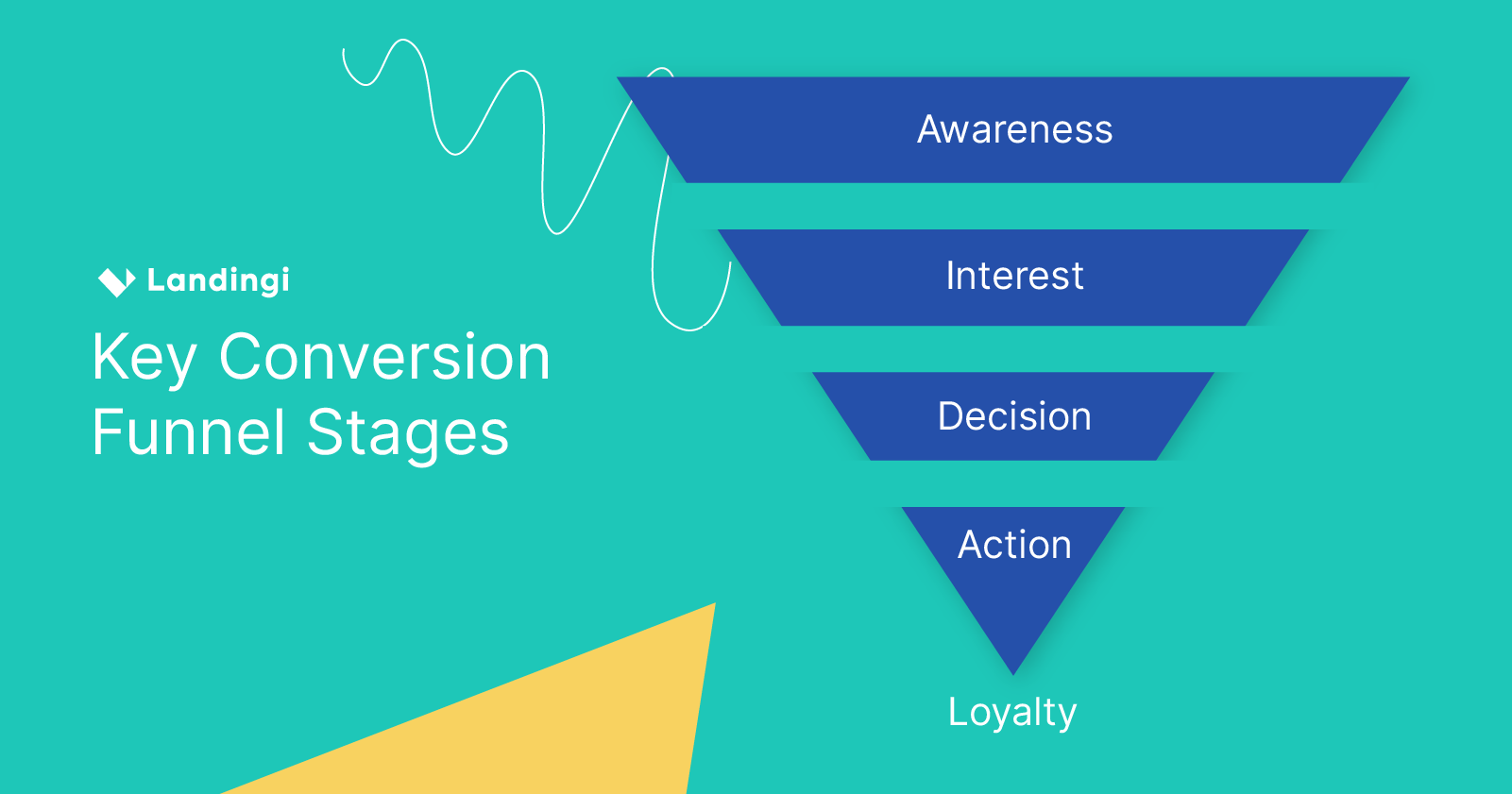
1st Stage: Awareness
The awareness stage is the threshold at which potential customers first encounter your brand or product. It marks the pivotal juncture where individuals become cognizant of a problem or need that your offering can adeptly address.
At this stage, your main goal is to increase the visibility and recognition of your solution. The wider the target you have, the wider the funnel is. You must make your target audience aware that you exist and offer something interesting. The challenge lies in capturing their attention and proffering valuable information that is useful and resonates with users’ needs.
How can you build awareness?
- Create high-quality, informative, and engaging content such as blog posts, articles, videos, infographics, and podcasts that address your target audience’s pain points or interests.
- Share this content on your website, social media platforms, and other relevant channels.
- Establish a strong presence on social media platforms where your target audience spends their time.
- Optimize your website for search engines so that it ranks higher in search results. Use relevant keywords, meta descriptions, and create valuable, keyword-rich content to attract organic traffic.
- Invest in paid advertising channels like Google Ads, Facebook Ads, Instagram Ads, and sponsored content on platforms where your audience is active.
- Collaborate with influencers in your industry or niche to reach their established, engaged audiences. Influencers can help create authentic and relatable content that introduces your brand to a wider audience.
- Participate actively in online forums, social media groups, and communities relevant to your industry.
- Encourage satisfied customers to leave positive reviews on platforms like Google, Yelp, or Trustpilot to enhance your online reputation.
2nd Stage: Interest
After building awareness among your potential leads, the next step is to build trust and fuel the interest of the visitors. As individuals transition into the interest stage, they actively seek more information. They begin exploring, ardently considering potential solutions to their predicaments.
At this juncture, your role assumes a nurturing stance, fostering and fortifying their burgeoning interest while adeptly positioning your product or service as the ultimate panacea they have been seeking.
What can you do to enhance interest?
- While developing content, use storytelling to engage your audience emotionally and make your brand more relatable.
- Provide informative content that helps potential customers learn about their problems and potential solutions. Publish how-to guides, tutorials, and educational videos that showcase your expertise.
- Utilize email marketing: send personalized and relevant content to subscribers based on their interests and behavior. Use email automation and email templates to nurture leads with a series of educational messages.
- Host webinars, workshops, or online classes related to your industry or product. These events provide opportunities to showcase your expertise and engage with potential customers in real-time.
- Share real-life case studies and success stories of customers who have benefited from your product or service.
- Offer free trials, demos, or product samples to let potential customers experience your offering firsthand.
3rd Stage: Decision
The decision stage is where potential customers are weighing their options and deciding whether or not to proceed towards making a purchase.
This is the point where persuasive tactics are most effective – providing strong reasons, addressing doubts, and alleviating objections become crucial, as the final decision is imminent. It is all about presenting your solution in a way that your audience will be eager to take action.
What can you do to influence the decision-making process?
- Offer detailed and transparent information about your product or service. Include specifications, pricing, and any terms and conditions. Address common questions and concerns to build trust and reduce friction.
- Highlight Unique Selling Points (USPs). Emphasize what sets your offering apart from competitors. Showcase the unique features, benefits, and value.
- Showcase social proof, such as the number of satisfied customers, awards, or certifications your brand has received.
- Create a sense of urgency by offering limited-time promotions, discounts, or exclusive deals. Highlight the potential savings or benefits of acting quickly.
- Provide easy-to-understand comparisons between your product and competing options. Use tables, charts, or visuals to highlight the advantages of your offering.
- Use compelling and action-oriented CTAs that prompt users to take the next step, such as “Buy Now,” “Get Started,” or “Book Your Appointment.”
4th Stage: Action
The action stage is the proverbial pot of gold at the end of the rainbow. This is where the magic happens – the point where potential customers metamorphose into actual buyers.
This stage embodies the culmination of all your efforts and strategic planning.
What strategies can you employ to sway the action?
- Streamline the online checkout process to reduce friction and make it as easy as possible for customers to complete their purchase. Minimize the number of steps, require only essential information, and offer guest checkout options.
- Provide a variety of payment options, including credit cards, digital wallets (e.g., PayPal, Apple Pay), and alternative payment methods (e.g., Klarna, Afterpay).
- Display trust symbols, SSL certificates, and security badges during the checkout process to reassure customers that their information is safe.
- Implement abandoned cart email campaigns to remind users of items left in their cart and encourage them to complete the purchase.
- Ensure that your website and checkout process are fully optimized for mobile devices, as an increasing number of users make purchases on smartphones and tablets.
- Utilize remarketing and retargeting. Continue targeting customers who have initiated the checkout process but didn’t complete it.
- Clearly communicate your return and refund policies, making it hassle-free for customers to return products if they are not satisfied.
- Offer lead magnets such as discounts, demonstrations of your product, free trial, free shipping, or loyalty points for completing an action, whether it’s a purchase or another desired conversion.
5th Stage: Loyalty
Loyalty is a phase where the customer journey doesn’t end but evolves into a lasting relationship. At this point, your goal is to turn one-time buyers into repeat customers and brand advocates. Building loyalty is essential for long-term success, as loyal customers not only continue to make purchases but also promote your brand to others.
Moreover, according to Khalid Saleh’s “Customer Acquisition Vs. Retention Costs – Statistics And Trends”, it’s more likely to make a sale to a customer who has already purchased from you, with a success rate of 60-70%. In contrast, the chances of selling to a new potential customer are much lower, with only a 5-20% probability of success.
What can you do to build loyalty?
- Implement reward and loyalty programs that offer incentives like discounts, exclusive access, or points for every purchase. For instance, a coffee shop might offer a free coffee after a certain number of visits.
- Use data and insights gathered from previous interactions to personalize communication. Send personalized recommendations, birthday offers, or anniversary thank-you messages to make customers feel valued.
- Provide exceptional customer service to address any issues or questions promptly. Resolve problems with a positive attitude and make customers feel heard and appreciated.
- Offer loyal customers exclusive content, early access to new products, or invitations to special events. This creates a sense of exclusivity and belonging.
- Ask for feedback and listen to customer suggestions. Implement improvements based on their input to show that you value their opinions.
- Identify opportunities to upsell or cross-sell related products or services to your loyal customers, increasing their lifetime value.
- Create a sense of community around your brand where customers can connect with each other. Online forums or social media groups dedicated to your brand can foster this community spirit.
How Do You Create a Conversion Funnel?
Creating a funnel is a process of elaborating a system that aims at moving the visitors down the funnel consistently to end up with people who are truly ready to purchase or subscribe.
There are five steps to build a conversion funnel that maximizes your chances of success: identifying target audiences, defining goals, creating compelling content, optimizing user experience, analyzing + iterating. Find a deeper explanation of these 5 steps below:
- Identify Your Target Audience: Research and understand your ideal customers. This involves creating detailed customer personas that encompass demographics, interests, pain points, and behaviors. By doing so, you can tailor your conversion funnel to address the specific needs of your target audience.
- Define Your Goals: Establish concrete goals for your conversion funnel. These goals can include actions like making a purchase, signing up for a newsletter, or requesting more information. Setting measurable objectives will help you track the effectiveness of your funnel. Additionally, having specific goals will help you craft precise messaging. For example, if you create a funnel for lead generation, offer a high-quality lead magnet that can increase the chances of conversion.
- Create Compelling Content: Develop high-quality, relevant, and engaging content that resonates with your audience at each stage of the funnel. This content can take various forms, such as blog posts, videos, infographics, and downloadable resources like ebooks or whitepapers. The key is to provide value and information that guides users toward your desired action.
- Optimize User Experience: Ensure that your website or landing pages are user-friendly, mobile-responsive, and load quickly. Streamline the navigation process, minimize distractions, and use clear calls-to-action (CTAs) to guide users toward the next step in the funnel. A/B testing can help you fine-tune these elements for maximum effectiveness.
- Analyze and Iterate: Regularly monitor the performance of your funnel using analytics tools. Track metrics such as conversion rates, bounce rates, and user behavior to gain insights into what’s working and what needs improvement. Based on this data, make iterative changes to your funnel to optimize its performance continuously. Experiment with different content types, CTAs, and layouts to see what resonates best with your audience.
Remember that creating an effective conversion funnel is an evolving process. Moreover, every funnel stage needs to be the continuity of the previous one creating a favorable journey for the visitors and engaging them more the further they go. Therefore, when creating your own marketing funnel, you need to make sure each stage has content that will be appealing to your potential customers.
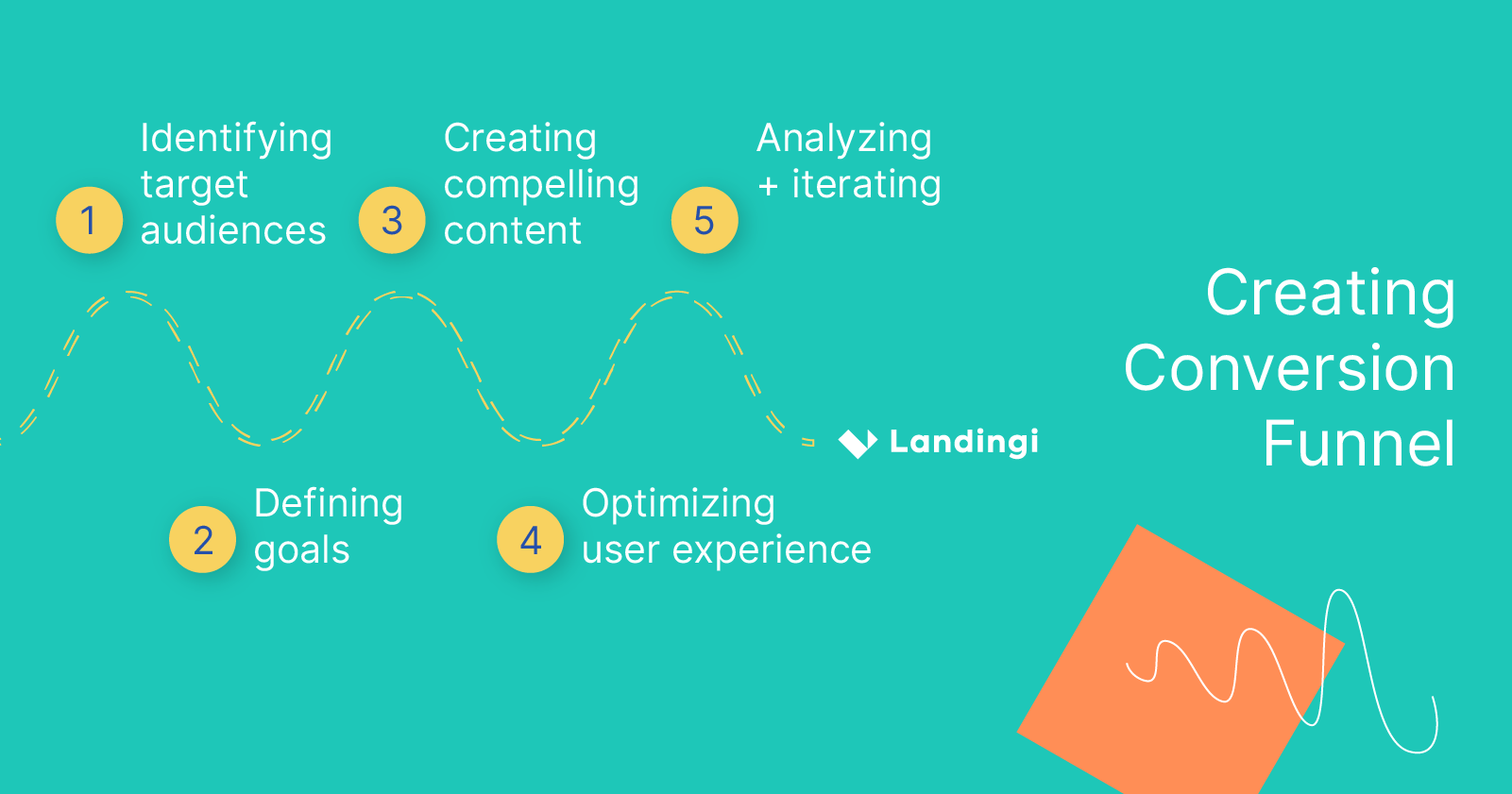
How To Optimize Conversion Funnels?
To optimize conversion funnels, it’s crucial to employ conversion rate optimization techniques. This involves enhancing the user experience by identifying what motivates, impedes, and convinces individuals on their journey. Essentially, optimizing marketing funnels involves providing the best possible experience for each user to increase the likelihood of conversion.
Analyzing and optimizing marketing funnels may be a critical factor in boosting conversion rates. Statistics show that the average conversion rate for websites is around 3%: Khalid Saleh (Invesp) in “The Average Website Conversion Rate by Industry (Updated 2023)” indicates that the average global conversion rate is 3.68%, and a report by Statista states that online conversion rates of e-commerce sites in 1st quarter of 2023 were the highest in the food and beverage sector, at 3.1 percent. Websites in the health and beauty sector trailed closely with a conversion rate of slightly less than three percent. For comparison, the average CR for e-commerce websites across all sectors was two percent. Nevertheless, WordStream reports that the top 25% of businesses achieve conversion rates of 5.31% or higher, while the top ten percent achieve 11.45% or more. This indicates significant opportunities for improving conversion funnel results. In fact, a case study “B2C Web Optimization” by Allison Banko from MarketingSherpa shows that optimizing one step in a funnel can lift conversions by 23% in under a week.
To effectively optimize, it’s essential to cater to the needs of each customer at every phase of the funnel. To illustrate this, let’s consider the three basic levels of the marketing funnel: the top, the middle, and the bottom.
- Optimizing Top Of The Funnel: In the conversion funnel optimization process, start by examining the methods by which you acquire new potential customers. Compare the channels that bring in customers and focus on the ones that work best for your target audience. Send out surveys to see how people discover your brand. If you’re using landing pages during the awareness stage, consider increasing their number – Pamela Vaughan from HubSpot, in her article titled “The Key to More Leads? Create More Targeted Conversion Opportunities!”, mentions that brands with more than 40 landing pages get 12 times more leads than those with just 1 to 5 landing pages.
- Optimizing Middle Of The Funnel: Take a closer look at how people are learning about your business. Ask yourself if your site is user-friendly and provides useful information, including pricing and product details. To enhance the user experience during the consideration phase, try incorporating product videos and pictures, crafting an FAQ section, writing case studies or blog posts, implementing search filters, collecting newsletter signups, offering discounts, and ensuring that your pages load quickly without any errors. Personalizing emails is also a good tactic, as that can boost conversions by 10% on average (according to Aberdeen Group).
- Optimizing Bottom Of The Funnel: During the conversion phase, removing as much friction as possible is crucial for conversion funnel optimization. This involves motivating people to complete the desired action. To improve the final stage of a marketing funnel, optimize your product pages with engaging descriptions, videos, and images. Simplify the checkout process and encourage customers to complete their purchases with clear pricing and feature information. By reducing the number of fields in your lead generation forms from 11 to 4, as suggested by Unbounce, you can achieve a conversion increase of up to 120%!
If you’re curious about the best strategies to optimize a sales process, we’ve put together a comprehensive guide on how to enhance conversion rates within a sales funnel.
How to optimize a conversion funnel for abandoned carts?
When optimizing a conversion funnel for abandoned carts, start by scrutinizing your data to identify the stages where users most often leave their carts behind. With this information in hand, you can then employ strategies such as remarketing, refining the checkout process, using exit-intent pop-ups, and experimenting with A/B testing.
According to the Baymard Institute’s “49 Cart Abandonment Rate Statistics 2023”, the average online shopping cart abandonment rate is 70.19%. A study by Statista revealed that the main reasons why consumers abandon their orders during the checkout process are extra costs (48%), the necessity of creating an account (24%), slow delivery (22%), not trusting a site (18%), and complicated checkout process (17%). That is why addressing and solving these issues is important to optimize and create an effective conversion funnel.
Here is a more detailed guide on how to optimize your conversion funnel for abandoned carts:
- Identify Abandonment Points: Delve into your data and determine the specific points where users typically abandon their shopping carts. This could be at certain stages in the checkout process or when unexpected costs pop up during the final stages of the purchase.
- Implement Remarketing: Engage once again with users who have abandoned their carts by employing retargeting strategies. Draw them back by sending personalized emails or showing them remarketing ads highlighting the products they left behind, enticing them to return and finalize their purchase.
- Streamline the Checkout Process: Make your checkout process as straightforward and user-friendly as possible to reduce friction. Eliminate any unnecessary steps, provide options for guest checkout, and ensure the form fields are intuitive and easy to use.
- Offer Incentives: Think about presenting appealing offers to lure users back to your site. Promotions, free delivery, or limited-time deals can serve as potent incentives for users to finalize their purchases.
- A/B Testing: Always be ready to test and tweak elements within your funnel. Play around with various messages, visuals, and calls-to-action to identify what truly clicks with your audience.
- Leverage Exit-Intent Pop-ups: Strategically implement exit-intent pop-ups. When a user shows signs of leaving, trigger a pop-up that presents an enticing offer or message, persuading them to reconsider their decision to abandon the site.
- Abandoned Cart Email Series: Set up an automated email series targeting users with abandoned carts. Send a series of well-timed, personalized emails reminding them of their items and offering assistance or incentives to complete the purchase.
- Mobile Optimization: Ensure that your cart and checkout process are mobile-responsive and user-friendly since many users shop on mobile devices.
Conversion Funnel Examples
Some examples will help illustrate the concept of conversion funnels more vividly and provide you with a practical understanding of how they are implemented in different business contexts.
- E-commerce Conversion Funnel: E-commerce businesses typically have a straightforward conversion funnel. It starts with raising awareness through advertising or organic search, followed by interest when the customer browses the product catalog. The decision stage includes reading reviews and comparing products, and the action stage is making the purchase. The loyalty stage is achieved through follow-up emails, customer service, and loyalty programs.
- SaaS Conversion Funnel: For a Software as a Service (SaaS) company, the conversion funnel might begin with a potential customer reading a blog post or watching a tutorial video (awareness). They then sign up for a free trial or demo (interest), use the software and compare it to competitors (decision), and finally subscribe to a paid plan (action). The loyalty stage includes regular use of the software, customer support, and potential upselling.
- Educational Institution Conversion Funnel: An educational institution might attract potential students through informative webinars or open days (awareness), send them course catalogs or invite them to meet with advisors (interest), offer campus tours or trial lectures (decision), and finally, the student applies and enrolls (action). The loyalty is achieved through quality education, ongoing support, and alumni networks.

Landing page conversion funnel examples
A landing page conversion funnel is a type of funnel that focuses on guiding visitors from the moment they land on a page to the point where they take a desired action. This action could be anything from signing up for a newsletter, making a purchase, or downloading a resource.
Landing page conversion funnels start when a visitor lands on a page and then uses engaging content, compelling calls-to-action, and persuasive elements such as testimonials or guarantees to encourage the visitor to take the desired action.
Landing pages are also a very convenient tool, as they can be created easily with landing page builders such as Landingi. These platforms offer a variety of templates and design tools that make it easy to build professional-looking, high-converting landing pages without needing any coding skills. Plus, they often include analytics features (e.g. Landingi’s EventTracker) that allow you to track the performance of your pages and optimize them for better results.
For instance, an e-commerce business might have a landing page that features a new product. The landing page marketing funnel for this could be:
- Awareness: A potential customer clicks on an ad or a link from a social media post and lands on the page.
- Interest: The landing page features engaging content about the product, including its benefits and features, which captures the visitor’s interest.
- Decision: The page might include customer testimonials, reviews, or a special promotion that helps the visitor decide to purchase the product.
- Action: The visitor adds the product to their cart and completes the purchase.
- Loyalty: After the purchase, the customer might receive a thank you email via an autoresponder with a discount code for their next purchase, fostering customer loyalty. They could also be directed to a thank you page that further enhances their post-purchase experience.
Another example could be a landing page for a software company offering a free trial of their product. The conversion funnel might look like this:
- Awareness: A potential customer finds the landing page through a search engine or a blog post.
- Interest: The landing page provides detailed information about the software and its benefits, sparking interest in the visitor.
- Decision: The page includes a demo video or a comparison chart that helps the visitor decide to try the software.
- Action: The visitor signs up for the free trial.
- Loyalty: After the trial, the customer receives an email offering a discount if they subscribe to a paid plan, promoting loyalty and repeat business.
These are just a few examples of how landing pages can be used to create effective conversion funnels. The specific steps and content will vary based on the business and the goals of the landing page.
Get 111 Landing Page Examples—The Ultimate Guide for FREE
Conversion Funnel Analysis
Conversion funnel analysis is a process that involves the examination of each stage of the flow to identify areas of improvement, bottlenecks, and opportunities to enhance conversions. It involves a detailed review of user behavior, engagement metrics, and conversion rates at every step of the funnel.
The goal of conversion funnel analysis is to understand how your audience is interacting with your funnel, where they are dropping off, and what might be causing these drop-offs.
Conversion funnel analysis typically involves the use of analytics tools to gather and analyze data. Key metrics to consider include the following:
- the number of users at each stage of the funnel,
- the conversion rate between each stage,
- the average time spent at each stage,
- the bounce rate.
Once the data is collected, it’s then about interpreting this information and making strategic decisions. For instance, if a large number of users are dropping off at the interest stage, it may indicate that your content isn’t effectively engaging your audience or addressing their needs. In this case, you might consider revising your content strategy or improving the quality of your content.
On the other hand, if users are reaching the decision stage but not taking action, it could suggest issues with your call-to-action, pricing, or perceived value of your offering. In such cases, you might consider offering promotional deals, highlighting the unique value proposition of your product or service, or A/B testing different CTAs. For this, you can use, for example, the A/B testing functionality from Landingi, with which you can experiment with different landing page variants and elements.
Sales Funnel Vs. Conversion Funnel
Is a conversion funnel the same as a sales funnel? Both models intend to direct prospective customers towards a particular objective. The main difference between a sales funnel and a marketing funnel is that the former is primarily geared towards generating sales, while the latter can be used to encourage any desired action a business wishes a customer to take.
The sales funnel primarily focuses on the process that leads a potential customer towards a purchase, mapping out the journey from the initial contact or awareness stage right through to the sale. It’s a model that helps businesses understand and optimize the customer’s purchase path.
On the other hand, the conversion funnel (or marketing funnel) is a broader concept. It not only includes the journey towards a purchase but also considers other types of conversions. These conversions could be any desired actions, such as filling out a form, signing up for a newsletter, or downloading an ebook. The conversion funnel allows businesses to understand and optimize the customer journey towards completing any desired action, not just a purchase.
Top of the funnel vs. bottom of the funnel marketing
Another difference worth mentioning is the difference between the top of the funnel marketing and the bottom of the funnel marketing. Top-of-the-funnel aims to attract and engage potential customers, while bottom-of-the-funnel focuses on converting those potential customers into actual customers.
That said, top of the funnel marketing refers to the strategies and tactics used to attract and engage potential customers who are at the initial stages of their buying journey. These individuals may not yet be aware of your brand or the solutions you offer, so the goal here is to raise awareness, educate, and build interest. This is achieved through content marketing, social media engagement, SEO, and other tactics designed to attract and engage a broad audience.
On the other hand, bottom of the funnel marketing targets individuals who are closer to making a purchase decision. They are already aware of your brand and have expressed interest in your offerings, so the goal here is to persuade and convert. This involves providing detailed product information, addressing objections, offering incentives, and using other tactics that encourage the potential customer to take the desired action, such as making a purchase or signing up for a service.
Why Is a Conversion Funnel Important?
The conversion funnel is crucial as it assists businesses in understanding and optimizing the customer journey, from the initial awareness stage to the desired action. This structured framework outlines a potential customer’s path, allowing businesses to pinpoint key touchpoints, obstacles, and engagement opportunities.
A well-designed marketing funnel can significantly enhance the effectiveness of your marketing efforts. According to a report by GetResponse, businesses that use marketing funnels have seen a 79% increase in leads and a 47% increase in sales. In addition, a study by Forrester Research found that companies that excel at lead nurturing generate 50% more sales-ready leads at a 33% lower cost.
Moreover, conversion funnels provide valuable insights into customer behavior and help increase customer lifetime value. By tracking and analyzing the actions of your audience, patterns, and trends emerge that can inform your marketing decisions.
This data-driven approach can lead to more effective and efficient marketing strategies, ultimately driving revenue growth.
Additionally, marketing funnels can help elevate the customer experience. By understanding the customer journey, you can create a more seamless and engaging experience that leads to higher conversions and fosters customer loyalty and advocacy.
Importantly, funnels offer the possibility of automation, making the conversion process more efficient and allowing businesses to save time and resources while still effectively guiding customers through their buying journey.
Let’s sum it up with the four most important benefits of marketing funnels which are as follows:
- boosting sales and conversions thanks to personalized nurturing interest and building trust and brand value among potential customers,
- enhancing customer engagement by creating personalized experiences and meaningful interactions that resonate with potential buyers,
- obtaining detailed insight into website visitors’ behaviors, enabling to close deals quicker,
- possibility of automation, making it possible to save both time and efforts.
What Is The Difference Between a Customer Journey And a Customer Journey Mapping?
A customer journey represents the entire path a customer takes when interacting with your brand, from initial awareness to post-purchase experiences, while customer journey mapping is a strategic process that visually outlines this journey.
These terms are closely related, but they represent different concepts in the realm of customer experience and marketing strategy.
The customer journey encompasses the whole path, from the initial discovery or awareness stage, through the consideration and decision-making process, to the final action or purchase, and even beyond that, to post-purchase interactions.
Customer journey mapping, on the other hand, is used to identify opportunities to improve the customer experience, streamline the purchase process, and ultimately, enhance customer satisfaction and loyalty. As a visual representation of the buyer’s journey, it highlights touchpoints, emotions, and potential pain points.
What Is The Difference Between a Customer Journey And a Conversion Funnel?
The customer journey describes the broader experience of a customer with a brand, encompassing all the interactions and touchpoints. Conversely, the conversion funnel is a more focused tool used to zero in on the different stages a customer moves through during the purchasing process.
The phrase “customer journey” refers to the comprehensive sequence a consumer undergoes when interacting with a company or brand so it encompasses every interaction from the initial brand discovery, through the evaluation and decision-making phases, to the final action or purchase, and even extends to post-purchase interactions. The customer journey is a holistic view of a customer’s experience.
On the other hand, “conversion funnels” are more specific frameworks used primarily in marketing to guide potential customers through a series of stages, ultimately leading to a conversion. The conversion funnel aims to strategically guide potential customers from one stage to the next, with the ultimate goal of achieving a conversion – be it a purchase, a sign-up, or any other desired action. It’s a more structured and strategic model that helps businesses analyze and optimize their marketing efforts.
Integrate Landingi Into Your Conversion Funnel Strategy
The exploration of conversion funnels highlights their crucial role in guiding potential customers through a structured journey from initial awareness to the final action. This journey is carefully mapped out through various stages such as awareness, interest, decision, action, and loyalty. It plays a vital role in enhancing customer engagement, nurturing leads, and ultimately driving conversions and revenue growth. The use of conversion funnels is not just a theoretical concept but a practical tool that has been proven to significantly boost sales and customer retention. This is evident from the increase in leads and sales reported by businesses employing these strategies.
Landingi is a well-known landing page builder that has become a key player in its domain by providing an intuitive platform for creating high-converting landing pages. The platform’s real significance lies in its ability to seamlessly integrate into the conversion funnel, particularly in the landing page stage. Landingi provides a range of templates, design tools, and crucial analytics features like EventTracker that empower businesses to craft compelling landing pages. These pages effectively guide visitors towards the desired action, whether it is signing up, making a purchase, or downloading a resource. By integrating Landingi into the conversion funnel strategy, businesses can enhance the efficiency and effectiveness of their digital marketing campaigns.

